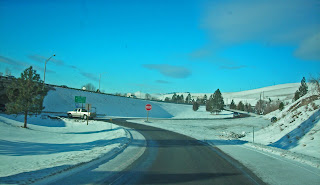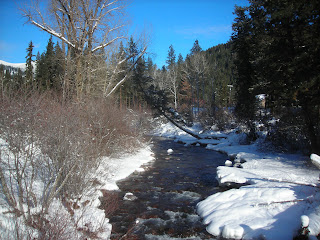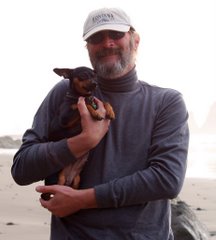 Interstate 90, Exit 104Missoula's Main Downtown Exit1/2 mile from our homeTaken 1-3-09 through the windshield
Interstate 90, Exit 104Missoula's Main Downtown Exit1/2 mile from our homeTaken 1-3-09 through the windshieldIt doesn't show signs of stopping,
And I've bought some corn for popping,
The lights are turned way down low,
Let It Snow! Let It Snow! Let It Snow!
--Sammy Cahn
NOTE: All photos can be seen full screen by double clicking on them. The complete set of photos I took on this outing can be seen on my Picasa web gallery. All pictures and links open in a new window.This winter may be headed for the records as one of the “worst” in recent history. So far, here in Montana’s “banana belt” we’ve had over a week with sub-zero temperatures and wind chills down to 40 below or lower. We’ve had snow that has fallen for days on end, and we’ve seen one storm front pass through and move on only to be replaced by a new storm front.
Regular readers will recall my December
post about getting caught on Lookout Pass behind a jack-knifed semi, or my report of our excursion to put a ham radio antenna up on top of a mountain where we were caught in a blizzard on
Labor Day. But please don’t get me wrong. I’m not complaining. As long as I’m not spending every free minute shoveling the stuff, I like the snow. I like the way the hills and mountains around town gleam white in the sun. I like sitting in the hot tub while the snow falls on my head and shoulders. I love watching the dogs bounce through the drifts in the yard. Well, Minnie bounces, seemingly oblivious to the cold and wet. Gypsy is a true California Girl, in the best Beach Boys’ fashion, and she tends to venture out as little as possible this time of year.
But the real joy of the season, for me, comes when I strap two long, thin strips of wood onto my feet and take off cross-country skiing. I understand that there are places in this country where “skiing” means being towed around some body of water behind a boat or jet ski. And I know as well that there are those whose idea of skiing involves paying exorbitant amounts of money to ride some contraption up a mountain then schuss back to the bottom, only to get in line for another ride up, ad nauseam. The skiing I prefer doesn’t require any motive power than my own heart, lungs and legs, no ropes, chairs, boats, lifts, or fancy clothing. A turtleneck, jeans, jacket, scarf, gloves and boots, and I’m all set. Oh, if the snow is deep I may well strap a pair of gaiters round my pant cuffs to keep them dry, but that’s as fancy as it gets.
My move back to Montana in January 1975 coincided with one of the snowiest winters we’ve seen in these parts. The first weekend I was back, I headed into Missoula and spent a little over $100 at the Trailhead, Missoula’s premier outdoors store at the time. For my C-note, I got a pair of boots, a pair of bamboo ski poles that I still use, thirty-three years later, and a beautiful pair of narrow, blue Kongsberg skis from Norway. I called them my Norwegian Wood. I left the skis on the front porch of the cabin and was out skiing every day from January into April, a minimum of three miles a day of cross-country skiing. I was twenty-five years old and in the best shape of my life. The Germans have a saying, “Langläufer leben länger” which means, “cross-country skiers live longer.” As I know a number of western Montanans who have skied into tree wells and died, I won’t swear to the accuracy of the statement, but I can’t think of a better form of aerobic exercise.
 Heading up Spring Gulch TrailRattlesnake Recreation AreaTaken 1-3-09 near Missoula, Montana
Heading up Spring Gulch TrailRattlesnake Recreation AreaTaken 1-3-09 near Missoula, MontanaWe’ve had very few winters as snow-bound as the winter of 1975, but I’ve made it a point to get out as much as I can when the ground is white and the sky is blue. There are two areas on the edge of Missoula where you can ski for miles, Pattee Canyon, south and east of the University campus, and the Rattlesnake Recreation Area, north of town and the entrance to the Rattlesnake Wilderness Area. There have been days when you could ski down the city streets, and I’ve skied to work numerous times in the past. New Year’s Day, I strapped on my Bushwackers, wider skis that do not require waxing and are wonderful for questionable conditions, and I skied down the street to pick up the bike path that fronts the railroad tracks three blocks from home.
Friday morning we woke to rain, and by noon the temperature was nearly 40 degrees in town. The snow started melting, and melting fast. I spent most of the day putting together and mounting an exhibition of my photography which will hang through the month of January in the Western Montana Gay and Lesbian Community Center. With twenty-two of my photographs framed and on display, this is the largest show I’ve had to date. It is largely the same show I had in Crescent City back in 2007, but at the last minute I decided I had to include some of portraits I’ve taken of various Sisters of Perpetual Indulgence from Eureka and the Russian River areas of California.
When I returned to the Center at 5 for the First Friday Art Walk, the temperature had begun to drop and the wet sidewalks and streets were turning to ice rinks. I was surprised at the number of people who braved the elements to visit the exhibit, but there was no where near the visitors from past openings. Between the weather and the fact that First Friday was the day after New Years, I’m not disappointed with the turn out.
Saturday dawned bright and clear, and Kevin surprised me by asking if I wanted to go skiing. Kevin is not a skinny-skis person, and his previous experience involved down-hill skiing or going on search and rescue missions on a snowmobile. Still, I was pleased that he’d ask, and was quickly ready to drag the equipment out of the shed and into the Expedition.
 Kevin "Boy, is this hard work"Spring Gulch TrailRattlesnake Recreation AreaTaken 1-3-09 near Missoula Montana
Kevin "Boy, is this hard work"Spring Gulch TrailRattlesnake Recreation AreaTaken 1-3-09 near Missoula MontanaWe headed up the Rattlesnake, as in my experience, it’s the most forgiving area nearby for new skiers. Of course, I’ve been doing this for over thirty years, so I have a tendency to forget just how awkward it can be trying to maneuver over snow pack and ice with seven feet of two inch wide wood or plastic strips fixed to your feet. Still, Kevin was game, and only fell three times getting out of the parking lot.
The Rattlesnake is one of Missoula’s favorite playgrounds, and the parking lot was full when we arrived. This meant that the trails were also filled with people of all ages walking or skiing. I didn’t see anyone on snow shoes this trip, but I have in the past. Most people were skiing in pairs or as groups of four, and we passed more than a few families with small children struggling to master the skills necessary to stay upright. My own parents were avid outdoors enthusiasts, but they were more attuned to summer and fall activities—hiking, fishing and hunting. Both my parents loved roller skating, and I had my first pair of roller skates before I could walk, but neither parent skied, so this was not something I grew up with. I wish I had. I do have a picture my father took of mother holding me up while roller skating, and we saw that scene repeated several times yesterday with parents and small children on skis.
When I first started skiing, I bought a book called The Cross-Country Skier’s Bible. It was great fun, but not a terribly good instruction manual, as I recall. I do remember reading somewhere that “if you can walk, you can cross-country ski.” In fact the writer continued, “Oh hell! If you can shuffle you can cross-country ski.” It’s not quite that simple, but almost. As long as you don’t mind shuffling with seven foot long, two inch wide boards on your feet. I keep mentioning the long, skinny nature of cross-country skis because it is the distinguishing feature of the sport.
I’m sure it was in the “Bible” that I read about the author’s adventure beginning to ski in Yosemite National Park. After two days of lessons, the man took out one morning on his own. Skiing up a narrow mountain trail, he eventually realized he was going to have to go back down the mountain. On the way back down, he noted that he was picking up quite a bit of speed and there appeared to be a tree right in the middle of the trail ahead of him. Trying desperately to remember what he had been taught about stopping, he couldn’t come up with anything. Finally, choosing discretion over valor, he fell down rather than run into the tree. Back in Yosemite Valley, he looked up his teacher and explaining what had happened on the trail, he said “I can’t remember how you told us to stop.” The ski instructor looked at the ground, cleared his throat a few times and mumbled “There’s no way to stop on cross-country skis.”
 Kevin "How do I slow these things down?"Spring Gulch RoadRattlesnake Recreation AreaTaken 1-3-09 near Missoula, Montana
Kevin "How do I slow these things down?"Spring Gulch RoadRattlesnake Recreation AreaTaken 1-3-09 near Missoula, MontanaKevin found this out personally. He kept trying to make his skinny skis behave the way downhill skis do. Downhill skis have metal edges on them that allow you to turn the ski on its side and cut into the snow or ice. Cross-country skis have no such edge. Downhill skis are wide, allowing you to angle them into what is called the snowplow position which, theoretically at least, slows you down. You can snowplow with cross-country skis, but the effect is neither as immediate nor as effective as with downhill skis. None of Kevin’s skiing experience prepared him for this lack of control.
Still, he was brave and agreed with me when I suggested climbing the trail that runs on the south side of Spring Gulch with the intent of skiing back down the road on the north side. I let him take the lead, in effect letting him set the pace. This also allowed me to stop periodically and pull my Nikon Coolpix L3 out of my parka pocket and capture some of the scenery. I kept hearing comments floating back on the breeze. “This is hard work.” “This is too much work.” “Ow,” as he fell yet again. But he kept getting back up and pressing on. I was so proud of him.
At mile 1.3, roughly half way up to the place where the trail and road merge, there is a bridge across Spring Gulch, and Kevin felt he’d worked hard enough getting that far. We crossed the gulch (one of the two places I fell), and started down the road. I prefer going up the trail and coming down the road because on the road there’s a little more room for error. The trail is one set of ski tracks wide, and winds among the trees and shrubs. I have skied down the trail, but you have to be on your guard the whole time, and frankly, I don’t find that much fun. I really didn’t want to be responsible for Kevin skiing into a tree. The problem with skiing down the road is that the snow tends to be skimpier and more prone to icing over. Still, I’ll take that route by preference. The Spring Gulch loop is my favorite local run, and had we gone all the way to where the trails merge, we’d have skied close to six miles. As it were, we covered between three and three and a half including the run from/to the parking lot.
It was a stunningly beautiful day, as I hope you can see in the pictures I’ve chosen to display here. The complete photographic record of our day is on Picasa, and you can
click here to access those photos. In a few I have tried to remove the blue cast from the shadowed snow, but I found in so doing, I also removed the blue from the sky. If you go to the Picasa site, click on F11 to see the slideshow in full screen mode.
One of the things I love about cross-country skiing is the way you glide through the woods with only the whoosh of your skis for sound. I have been skiing with two different friends who felt they had to fill the silence with talk, and I have to admit that I’ve never asked those friends to accompany me a second time. I love being out by myself, but as I get older, I no longer feel that it is wise to take off for a day in possibly adverse conditions without someone along, as the Scots say, in case. Yesterday, the only person I saw skiing alone, was not really alone. She came skiing down the trail completely engrossed in a conversation on her cell phone. Brave new world, indeed.
I’m looking forward to lots more ski trips, including a few to some of my favorite places, Lolo Pass on the Montana/Idaho border (US Highway 12), St. Joseph Pass (Montana highway 43, just above the Montana/Idaho border on US 93), and Mount Haggin between the communities of Anaconda and Wise River, Montana. Lolo Pass is 45 miles from Missoula, and St. Joseph Pass and Mount Haggin are roughly 100 miles from home, albeit in different directions. I won’t be carrying the D80 with me, but the Coolpix takes fine pictures and fits in my jacket pocket. I’ll keep you informed.
 Rattlesnake Creek (formerly Missoula's main water source)Taken 1-3-09 near Missoula, Montana
Rattlesnake Creek (formerly Missoula's main water source)Taken 1-3-09 near Missoula, Montana
 One of the first portraits I took of Gary
One of the first portraits I took of Gary Gary, Annie Wright, and Billy the Ass
Gary, Annie Wright, and Billy the Ass Gary watering the dogs
Gary watering the dogs Gary at the gates to Ashland
Gary at the gates to Ashland The Restaurant Cat
The Restaurant Cat








